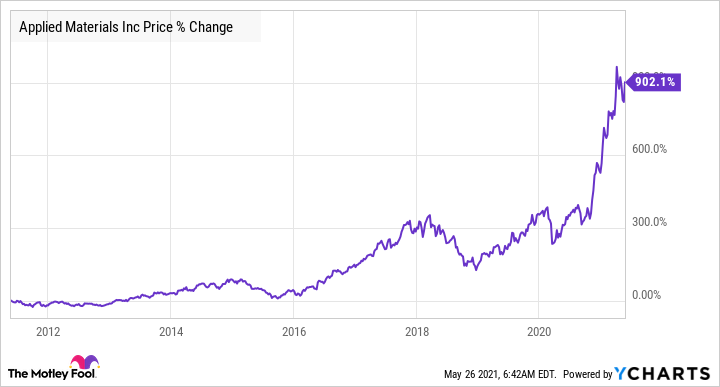A $1,000 investment in Applied Materials (AMAT -2.79%) stock made a decade ago would be worth more than $10,000 today, which seems a tad surprising as the tech company's revenue and earnings didn't grow at particularly eye-popping rates over that period.
The company, which supplies key fabrication equipment, services, and software that semiconductor manufacturers use to make their chips, had a 10-year compound annual revenue growth rate of just 6.06%. It brought in $9.55 billion in revenue in its fiscal 2010; that increased to $17.2 billion in its fiscal 2020, which ended Oct. 25. Its non-GAAP net income increased from $1.18 billion to $3.85 billion over the same period, translating to a compound annual growth rate (CAGR) of 12.54%.
AMAT data by YCharts
Meanwhile, the tech-heavy Nasdaq-100 index has registered a CAGR of 12% in revenue and 20% in earnings since 2003. And the index is up by almost 500% over the past decade, which is impressive. But Applied Materials stock has beaten it handsomely despite underperforming in terms of top- and bottom-line growth.
The good news for investors is that Applied Materials looks well-positioned to beat the broader market's revenue and earnings growth over the next decade, which could lead to even stronger stock price growth than it delivered in the last one.
Benefiting from the global chip shortage
The novel coronavirus pandemic gave Applied Materials a huge shot in the arm last year as global demand for semiconductor chips shot up to support the shift to remote work and online education. Semiconductor sales jumped 6.5% worldwide to $439 billion in 2020, over-straining a supply chain that was already impaired by the COVID-19 crisis.
Not surprisingly, chipmakers scrambled to add manufacturing capacity in a bid to meet the surging demand. Applied Materials benefited from this and finished its fiscal 2020 with an 18% increase in revenue and a 37% increase in adjusted earnings per share. Fiscal 2021 so far is turning out to be an even better year as semiconductor companies continue to spend billions of dollars to ramp up production capacity.

Image source: Getty Images.
In its recently concluded fiscal second quarter, Applied Materials' revenue increased 41% year over year to $5.58 billion, while adjusted earnings soared 83% to $1.63 per share. Those results easily exceeded the company's guidance and were far better than the company's fiscal Q1 revenue and earnings growth rates of 24% and 42%, respectively.
Based on the company's guidance, this surge is not running out of steam. The company anticipates non-GAAP earnings of $1.76 per share this quarter on revenue of $5.92 billion, which is much higher than Wall Street's expectations of $1.56 per share in earnings on $5.53 billion revenue. The company delivered $1.06 per share in earnings on revenue of $4.4 billion in the prior year period.
In sum, Applied Materials' growth has accelerated over the past year as semiconductor demand has increased. More importantly, the massive end-market opportunity indicates that it could keep growing at similarly high rates for a long time to come.
A multiyear growth opportunity lies ahead
Semiconductor demand is expected to rise by a double-digit percentage this year. VLSI Research estimates an 11% increase in chip demand in 2021 following last year's 7% increase. That's expected to result in supply shortages persisting into the second half of the year. As a result, chipmakers are expected to keep adding more capacity.
Industry association SEMI forecasts an increase of 15.5% in spending on fabrication equipment this year, followed by a 12.2% spike in 2022. Major semiconductor foundries across the globe have already announced huge plans for infrastructure investments.
Taiwan Semiconductor Manufacturing, for instance, has announced it will invest $100 billion over the next three years to increase fabrication capacity. Intel has also outlined plans for $20 billion in investments to expand its chip manufacturing capacity in the U.S., while South Korean giant Samsung recently said that it would invest $151 billion in non-memory chip production through 2030.
The Korea Semiconductor Industry Association estimates that through 2023, that country's chipmakers will pour a combined 510 trillion won (around $457 billion) into growing their chip-making capacity. All of this is great news for Applied Materials -- the company gets 53% of its total revenue from Korea, Taiwan, and the U.S.
Such huge investments will be necessary for chipmakers to meet the world's growing need for semiconductors. The global semiconductor market was worth $439 billion last year, and one third-party estimate forecasts that by 2030, it will exceed annual sales of $1 trillion.
In all, it can be said that Applied Materials is built for long-term growth, as evidenced by the 20%-plus annualized earnings growth analysts are forecasting for it over the long run. More importantly, investors looking to add a top growth stock to their portfolio should consider buying Applied Materials straight away. It's trading at less than 19 times forward earnings, which is an attractive valuation considering its solid and rapid growth pace.





